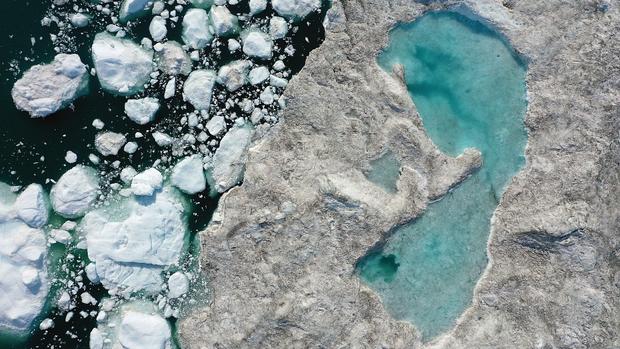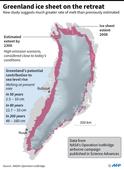 In this aerial view, melting ice forms a lake on free-floating ice jammed into the Ilulissat Icefjord during unseasonably warm weather near Ilulissat, Greenland, on July 30, 2019. (PHOTO / VCG)
In this aerial view, melting ice forms a lake on free-floating ice jammed into the Ilulissat Icefjord during unseasonably warm weather near Ilulissat, Greenland, on July 30, 2019. (PHOTO / VCG)
WASHINGTON - Melting on the ice sheets has accelerated so much over the past three decades that it’s now in line with the worst-case climate warming scenarios outlined by scientists.
A total of 28 trillion metric tons of ice was lost between 1994 and 2017, according to a research paper published in The Cryosphere on Monday. The research team led by the University of Leeds in the UK was the first to carry out a global survey of global ice loss using satellite data.
A total of 28 trillion metric tons of ice was lost between 1994 and 2017, according to a research paper published in The Cryosphere on Monday. The research team led by the University of Leeds in the UK was the first to carry out a global survey of global ice loss using satellite data
“The ice sheets are now following the worst-case climate warming scenarios set out by the Intergovernmental Panel on Climate Change,” lead author Thomas Slater said in a statement. “Although every region we studied lost ice, losses from the Antarctic and Greenland ice sheets have accelerated the most.”
Ice melt from sheets and glaciers contributes to global warming and indirectly influences sea level rise, which in turn increases the risk of flooding in coastal communities.
ALSO READ: Sea of slush: Arctic sea ice lows mark a new polar climate regime
Earth’s northern and southern poles are warming more than twice as fast as the rest of the planet. In 2020, a year of record heat, Arctic sea ice extent hovered around the lowest ever for most of the year.
The new research, which used information from the European Space Agency’s network of satellites, found that Earth lost 1.3 trillion tons of ice in 2017, accelerating from 0.8 trillion metric tons per year in the 1990s.
The ice lost is equivalent to a 100-meter-thick sheet of ice able to cover the whole of the UK.
Another way to think of it is as 28 giant ice cubes —one for every trillion metric tons of ice lost—each taller than Mount Everest and measuring 10 kilometers in width, height and depth, the scientists said.
“One of the key roles of Arctic sea ice is to reflect solar radiation back into space, which helps keep the Arctic cool,” said Isobel Lawrence, a researcher at the Leeds’ Centre for Polar Observation and Modelling. “As the sea ice shrinks, more solar energy is being absorbed by the oceans and atmosphere, causing the Arctic to warm faster than anywhere else on the planet.”
ALSO READ: Record Greenland ice loss poses threat to coastal cities worldwide
The survey, which also analyzed 215,000 mountain glaciers around the planet, concluded that half of the losses were from ice on land, including from mountain glaciers and the Greenland and Antarctic ice sheet.
These losses have raised global sea levels by an estimated 35 millimeters.
 This June 20, 2019, graphic shows a forecast on Greenland's melting ice sheet, according to data from NASA Operation IceBridge. (GRAPHIC / AFP)
This June 20, 2019, graphic shows a forecast on Greenland's melting ice sheet, according to data from NASA Operation IceBridge. (GRAPHIC / AFP)
Meanwhile, the head of the International Monetary Fund said on Monday that it views climate change as a fundamental risk to economic and financial stability.
IMF Managing Director Kristalina Georgieva told the Climate Adaptation Summit that global economic output could expand by 0.7 percent over the next 15 years and millions of jobs could be created if carbon prices rose steadily and investments expanded in green infrastructure.
ALSO READ: Greenland ice has shrunk beyond return, study finds
“We see climate as a fundamental risk for economic and financial stability, and we see climate action as an opportunity to reinvigorate growth, especially after the pandemic, and to generate new green jobs,” Georgieva said.
She said the IMF was taking action in four areas to accelerate the transition to a new low-carbon and climate-resilient economy.
Georgieva said the Fund would launch a new “Climate Change Dashboard” this year to track the economic impact of climate risks and the measures taken to mitigate them, a key step to ensuring the needed shift.
“Climate resilience is a critical priority,” she said. “This is why we place it at the heart of what do, this year and (in) the years to come.”
READ MORE: Europe's record heatwave threatens Greenland ice sheet
The Fund is also integrating climate factors into its annual economic country assessments, also known as Article IV consultations, focusing on adaptation in highly vulnerable countries, and carbon pricing in its assessment of large emitters, Georgieva said.
In addition, she said the IMF is adopting enhanced stress tests and standardizing disclosure of climate-related financial stability risks in its financial-sector surveys, and expanding its training and support to help central banks and finance ministries take climate considerations into account.
With Reuters inputs


